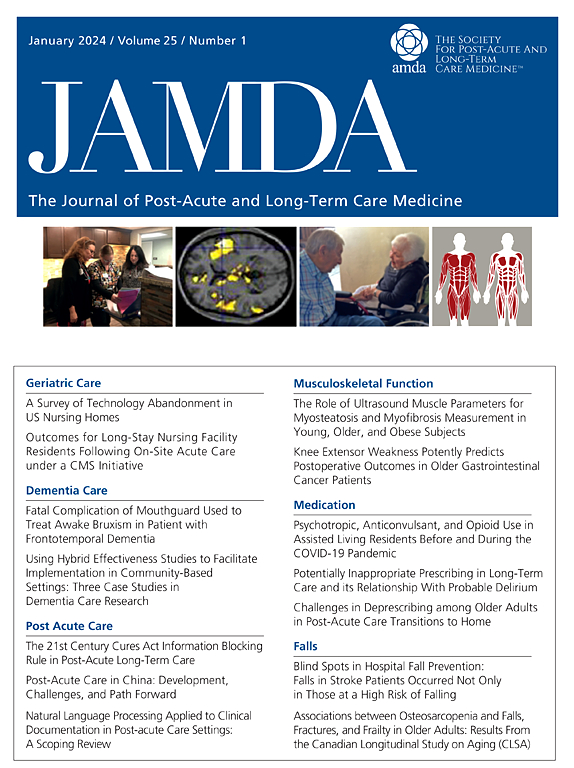Impact of Severe Dyspnea on Mortality and Disability: A 9-Year Cohort Study of Older Adults in Japan
IF 4.2
2区 医学
Q2 GERIATRICS & GERONTOLOGY
Journal of the American Medical Directors Association
Pub Date : 2025-05-10
DOI:10.1016/j.jamda.2025.105609
引用次数: 0
Abstract
Objectives
We investigated the association of severe dyspnea and frailty with all-cause mortality and disability in Japanese community-dwelling older adults.
Design
A 9-year follow-up cohort study.
Setting and Participants
We enrolled 3499 community-dwelling adults aged ≥65 years without disabilities or residence in care facilities who completed a baseline survey in 2013.
Methods
Dyspnea was assessed via a questionnaire on severe dyspnea during daily activities, and frailty status was determined using the Kihon Checklist. Disability was defined as new long-term care insurance certification. Cox proportional hazard models were used to calculate hazard ratios for mortality and disability. Fine-Gray regression models were used to calculate subdistribution hazard ratios for disability while accounting for mortality as a competing risk and adjusting for confounders. Both analyses were stratified by frailty status.
Results
Severe dyspnea was present in 240 participants (6.9%). Overall, the incidence rate of mortality was 6.37 and 2.55 per 100 person-years, and that of disability was 9.96 and 5.06 in the dyspnea and no-dyspnea groups, respectively. Severe dyspnea was associated with a hazard ratio of 1.67 (95% CI, 1.35-2.07) for mortality and 1.38 (95% CI, 1.14-1.67) for incident disability in the frailty group. After accounting for death as a competing risk using the Fine-Gray regression model, the subdistribution hazard ratio for new disability associated with severe dyspnea was 1.38 (95% CI, 1.12-1.70) in the frailty group.
Conclusions and Implications
Severe dyspnea was associated with an increased risk of both mortality and incident disability, particularly among participants in the frailty group. These findings highlight the heightened vulnerability of frail older adults to dyspnea-associated adverse outcomes.
严重呼吸困难对死亡率和残疾的影响:日本老年人9年队列研究
目的:研究日本社区老年人严重呼吸困难和虚弱与全因死亡率和残疾的关系。设计一项为期9年的随访队列研究。环境和参与者:我们招募了3499名年龄≥65岁、无残疾或居住在护理机构的社区成年人,他们在2013年完成了基线调查。方法通过日常活动中严重呼吸困难问卷评估呼吸困难,并使用Kihon检查表确定虚弱状态。残疾被定义为新的长期护理保险认证。Cox比例风险模型用于计算死亡率和致残率的风险比。细灰色回归模型用于计算残疾的亚分布风险比,同时将死亡率作为竞争风险考虑在内,并对混杂因素进行调整。两项分析均按虚弱状态分层。结果重度呼吸困难240例(6.9%)。总体而言,呼吸困难组和非呼吸困难组的死亡率分别为6.37和2.55 / 100人年,致残率分别为9.96和5.06 / 100人年。在虚弱组中,严重呼吸困难与死亡率的风险比为1.67 (95% CI, 1.35-2.07),与意外致残的风险比为1.38 (95% CI, 1.14-1.67)相关。在使用Fine-Gray回归模型将死亡作为竞争风险考虑后,在虚弱组中,与严重呼吸困难相关的新残疾的亚分布风险比为1.38 (95% CI, 1.12-1.70)。结论和意义严重呼吸困难与死亡率和意外致残风险增加相关,特别是在虚弱组的参与者中。这些发现强调了体弱多病的老年人对呼吸困难相关不良后果的高度脆弱性。
本文章由计算机程序翻译,如有差异,请以英文原文为准。
求助全文
约1分钟内获得全文
求助全文
来源期刊
CiteScore
11.10
自引率
6.60%
发文量
472
审稿时长
44 days
期刊介绍:
JAMDA, the official journal of AMDA - The Society for Post-Acute and Long-Term Care Medicine, is a leading peer-reviewed publication that offers practical information and research geared towards healthcare professionals in the post-acute and long-term care fields. It is also a valuable resource for policy-makers, organizational leaders, educators, and advocates.
The journal provides essential information for various healthcare professionals such as medical directors, attending physicians, nurses, consultant pharmacists, geriatric psychiatrists, nurse practitioners, physician assistants, physical and occupational therapists, social workers, and others involved in providing, overseeing, and promoting quality

 求助内容:
求助内容: 应助结果提醒方式:
应助结果提醒方式:


